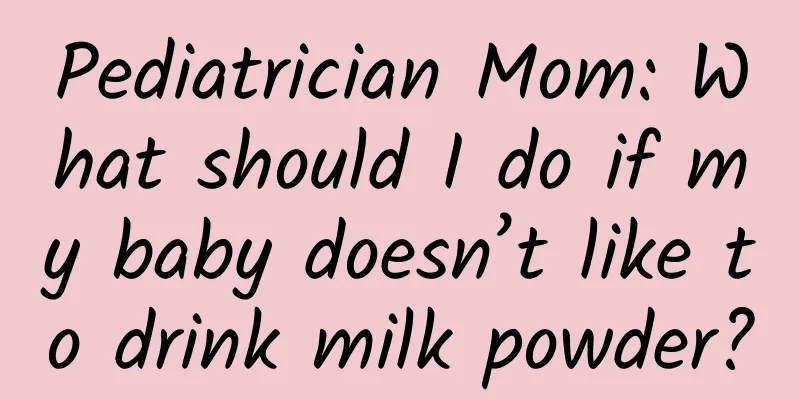Pediatrician Mom: What should I do if my baby doesn’t like to drink milk powder?

|
The following article comes from Pediatrician Mom, author Xiami Mommy Pediatrician Mom With the conscience of a mother with professional medical knowledge, I can speak for the babies and answer questions for the parents. This is the 3216th article of Da Yi Xiao Hu The children are often right. The children are often right. The children are often right. Parents ask: [I don’t feel my milk swelling, and the amount of milk I squeeze out each time is very small. I’m worried that my breast milk is not enough, so I added formula milk, but my baby doesn’t want to drink the formula milk. What should I do? ] Parents ask: [My baby keeps asking for milk, and I always leak milk. I’m worried that my breast milk is not enough, so I added formula milk, but my baby doesn’t want to drink the formula milk. What should I do? ] First of all, not every mother will have the feeling of breast engorgement. Instead, breastfeed on demand. Feed the baby when he wants to eat and feed when her milk is engorged. 2 to 3 months after delivery, the amount of milk secretion and the baby's needs will reach a balance, and you will not easily feel breast engorgement. Then, breast milk will not be completely emptied, and the amount of milk squeezed out does not equal the actual milk production. Milking is a skill that needs to be learned, and not all breast pumps can easily extract milk. Next, the baby needs some adjustment in the first few weeks when learning to breastfeed. A few days after discharge from the hospital, about 2 weeks, 4 to 6 weeks, and 3 to 6 months, the baby will be in a "growth spurt" and his needs will increase. During teething, the baby will stop eating because of gum discomfort. When encountering physical discomfort or too much external stimulation, the baby will also want to suck breast milk for comfort. The baby will also choose to "concentrate on breastfeeding" when the mother stops working and doing housework or during a certain period of time during the day. These are all normal phenomena and there is no need to worry too much. Also, milk leakage is actually a normal effect of oxytocin, which means that the milk is flowing smoothly, the body position has changed or the breast capacity has reached a certain level, which means that the breast's self-protection mechanism is functioning well. Breastfeed frequently to reduce milk engorgement, and everything will be fine when the supply and demand are balanced. If it is because of "not enough milk", we can explain the reason and put aside the worries; if it is because the baby does not suck enough or the breastfeeding posture is not right, etc., we can find the reasons and improve them. Adding milk powder does not solve the fundamental problem, but will reduce milk secretion. Many milk powders do not need to be added. Parents ask: [My baby has started to eat complementary food, and I changed to feeding him formula milk, but he doesn’t want to drink the formula milk, what should I do? ] A: Adding complementary foods does not mean that you need to switch to formula milk for your baby! Many parents have misunderstood that complementary foods are complementary foods, which can include yogurt and cheese, but never formula milk! As long as the mother's breast milk is enough to guarantee the child's daily milk needs, breastfeeding can still be done after adding complementary foods, and there is no need to switch to (or add additional) formula milk. Adding complementary foods does not mean weaning from breastfeeding! Parents ask: [The elders in my family often say that breast milk has no nutritional value after 6 months. Is that true? When is the best time to breastfeed? ] Answer: Breast milk can provide more than 50% of the daily energy required by infants aged 6-11 months. 500 ml of breast milk a day can provide about 30% of the daily energy required by a 2-year-old child, and still provide a considerable amount of immune substances. The World Health Organization and UNICEF call on mothers around the world to exclusively breastfeed their babies for the first six months of life to achieve optimal growth, development and health. After that, to meet their evolving nutritional needs, babies should be given nutritious complementary foods while continuing to breastfeed until they are two years old or older. Parents ask: [I also know that breastfeeding is good, but for various reasons, I am ready to start weaning my baby off breast milk. Should I give my baby formula milk or milk? I heard that formula milk should be consumed until the age of 3. Is that true?] A: If the baby is within 6 months and before complementary food is added, and the mother's breast milk cannot guarantee the child's daily milk demand, the baby's calorie intake is insufficient, and additional formula milk powder is needed. If it is determined that you need to start weaning for various reasons, you first need to buy suitable formula milk and bottles, and use breast milk to adapt the baby to the bottle. Choose the meal during the day when the baby is in a good mood to try. After the baby can accept breast milk and bottle feeding, add a small amount of soaked milk powder to the breast milk (note that it is soaked milk powder, not milk powder made with breast milk), and observe whether the baby has allergies. If not, gradually increase the amount of soaked milk powder. During this process, you can still consider continuing to chase milk. You can use temporary milk next to the breast or milk cup to add milk. For chasing milk, refer to the article Pediatrician Mom's Mailbox: Not enough milk, afraid of emptying the breast, but also want to chase milk, what to do (click on the title to read). If the baby has started to eat complementary foods, as long as the baby is not clearly allergic to milk protein, yogurt and cheese can be tried from 8 months old, because the lactose in yogurt and cheese has been broken down and the milk protein has been partially hydrolyzed; start trying fresh milk from 1 year old to achieve a balanced diet, and formula milk is not a must-have. This article was completed in 2014 and revised in 2017 |
<<: How to choose medication during an acute migraine attack?
Recommend
Precautions for pregnant women during miscarriage
Women are very weak after abortion, so they need ...
Are you doing the right thing about drinking water?
Text: Ye Mingzhu, Union Hospital Affiliated to To...
Can I eat olives during early pregnancy?
After most women become pregnant, their tastes ch...
Can I drink dandelion granules while breastfeeding?
Some patients who are breastfeeding have asked he...
Will itching caused by pubic hair rubbing against the genitals cause inflammation?
Many people will find that their lower body is no...
AED worth tens of thousands of yuan can be taken out by breaking the window! How to use an automatic external defibrillator?
China Science and Technology News Network, Februa...
Is loofah hot or cold? Why does loofah have an earthy smell? What are the medicinal values of loofah?
You may not know that the whole body of the loofa...
Things to note before hysterosalpingography
There are some things that women need to pay atte...
Blood sugar is unstable, are you eating right?
This is the 5295th article of Da Yi Xiao Hu We em...
How do you know if your fallopian tubes are open?
If a woman has a blocked fallopian tube, it will ...
How many months is the most accurate in measuring biparietal diameter?
Pregnancy should be one of the happiest days in a...
How to keep loofah fresh for a long time? Can loofah be frozen?
Sponge gourd is a summer vegetable. When it is pu...
How to make Schefflera affine by cuttings? Why doesn't Schefflera affine grow tall?
Schefflera arborvitae, also known as Schefflera a...
Is it normal for girls to have hair on their stomachs?
It is a normal phenomenon for female friends to h...
Which is better, Macau's Ruins of St. Paul's or Venice? How to get to Venice from Macau's Ruins of St. Paul's?
Macau is one of the special administrative region...









